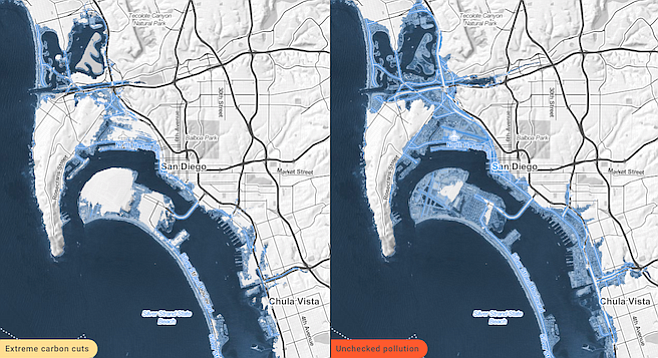 Facebook
Facebook
 X
X
 Instagram
Instagram
 TikTok
TikTok
 Youtube
Youtube

A group of scientists studying climate change this week released a series of maps illustrating projections of the effects of sea levels rising for coastal communities around the globe, including San Diego.
The maps offer several different ranges of possible scenarios between now and the end of the century, including continued global reliance on fossil fuels and reduction of carbon pollution ranging from "minor" to "extreme."
None of the scenarios on Climate Central's Surging Seas map look promising.
Even undertaking "extreme" measures to curb carbon use worldwide, by the year 2100 the group predicts temperatures will melt polar ice sufficient to raise water levels in the Pacific 9.5 feet, at which point all of Mission Beach becomes permanently submerged. The idea isn't new, as local research raised this possibilityin 2013, but the new maps also indicate the flooding of the Silver Strand could turn Coronado into an actual island, along with Point Loma.
The default setting of "unchecked pollution" is more unsettling, with Ocean Beach, significant portions of downtown, and much of the land from the airport to the Sports Arena permanently submerged, along with all of the manmade islands carved out of Mission Bay. These figures assume warming of 7.2 degrees by the century's end, and an accompanying 29.2 feet of rising oceans.
Climate Central activists (who describe themselves as "an independent organization of leading scientists and journalists researching and reporting the facts about our changing climate and its impact on the American public") say they can pinpoint when emissions might reach a point at which a certain level of sea rise is locked in, but they can't say how long it will actually take for the water to arrive.
"The answer could be sooner than 200 years from now, or as long as 2,000 years," the group explains. "Why the wide range? It is easier to estimate how much ice will eventually melt from a certain amount of warming, than how quickly it will melt, which involves more unknowns. The same simple contrast would apply to an ice sculpture in a warm room."


A group of scientists studying climate change this week released a series of maps illustrating projections of the effects of sea levels rising for coastal communities around the globe, including San Diego.
The maps offer several different ranges of possible scenarios between now and the end of the century, including continued global reliance on fossil fuels and reduction of carbon pollution ranging from "minor" to "extreme."
None of the scenarios on Climate Central's Surging Seas map look promising.
Even undertaking "extreme" measures to curb carbon use worldwide, by the year 2100 the group predicts temperatures will melt polar ice sufficient to raise water levels in the Pacific 9.5 feet, at which point all of Mission Beach becomes permanently submerged. The idea isn't new, as local research raised this possibilityin 2013, but the new maps also indicate the flooding of the Silver Strand could turn Coronado into an actual island, along with Point Loma.
The default setting of "unchecked pollution" is more unsettling, with Ocean Beach, significant portions of downtown, and much of the land from the airport to the Sports Arena permanently submerged, along with all of the manmade islands carved out of Mission Bay. These figures assume warming of 7.2 degrees by the century's end, and an accompanying 29.2 feet of rising oceans.
Climate Central activists (who describe themselves as "an independent organization of leading scientists and journalists researching and reporting the facts about our changing climate and its impact on the American public") say they can pinpoint when emissions might reach a point at which a certain level of sea rise is locked in, but they can't say how long it will actually take for the water to arrive.
"The answer could be sooner than 200 years from now, or as long as 2,000 years," the group explains. "Why the wide range? It is easier to estimate how much ice will eventually melt from a certain amount of warming, than how quickly it will melt, which involves more unknowns. The same simple contrast would apply to an ice sculpture in a warm room."
Comments